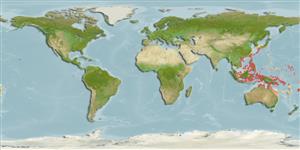>
Gobiiformes (Gobies) >
Gobiidae (Gobies) > Gobiinae
Etymology: Amblygobius: Greek, amblys = darkness + Latin gobius = gudgeon (Ref. 45335).
Eponymy: Captain Francis Link was a Police Officer and long-time resident of Jolo, in the Philippines. [...] (Ref. 128868), visit book page.
More on author: Herre.
Environment: milieu / climate zone / depth range / distribution range
Ecología
marino asociado a arrecife; rango de profundidad 1 - 10 m (Ref. 86942). Tropical
Western Central Pacific: Iriomotejima and the Philippines; also from West New Guinea.
Tamaño / Peso / Age
Maturity: Lm ? range ? - ? cm
Max length : 6.5 cm TL macho / no sexado; (Ref. 90102)
Short description
Claves de identificación | Morfología | Morfometría
Espinas dorsales (total) : 6 - 7; Radios blandos dorsales (total) : 13; Espinas anales: 1; Radios blandos anales: 12. Characterized by generally whitish body color with three black stripes on upper two-thirds of head and body; presence of diffuse narrow bars on side; first and second dorsal fin equal in height; rounded caudal fin; longitudinal scale series 60; fully scaled predorsal region; scales dorsally on opercle, absent on cheek; ctenoid body scales; cycloid scales on nape, abdomen, and opercle; depth of body 4.5-4.8 in SL (Ref. 90102).
Occurs on silty mud flats among the aerial roots of mangroves (Ref. 37816). Also found in stream mouths or occasionally in saline lakes in 0-3 m (Ref. 90102). Max. length (Edward O. Murdy, pers. comm., 1998).
Life cycle and mating behavior
Madurez | Reproducción | Puesta | Huevos | Fecundidad | Larva
Masuda, H., K. Amaoka, C. Araga, T. Uyeno and T. Yoshino, 1984. The fishes of the Japanese Archipelago. Vol. 1. Tokai University Press, Tokyo, Japan. 437 p. (text). (Ref. 559)
IUCN Red List Status (Ref. 130435: Version 2024-1)
Threat to humans
Harmless
Human uses
Herramientas
Special reports
Download XML
Fuentes de Internet
Estimates based on models
Preferred temperature (Ref.
123201): 25.4 - 29.3, mean 28.8 °C (based on 1314 cells).
Phylogenetic diversity index (Ref.
82804): PD
50 = 0.5000 [Uniqueness, from 0.5 = low to 2.0 = high].
Bayesian length-weight: a=0.00724 (0.00339 - 0.01546), b=3.10 (2.92 - 3.28), in cm total length, based on LWR estimates for this (Sub)family-body shape (Ref.
93245).
Nivel trófico (Ref.
69278): 3.0 ±0.2 se; based on size and trophs of closest relatives
Resiliencia (Ref.
120179): Alto, población duplicada en un tiempo mínimo inferior a 15 meses (Preliminary K or Fecundity.).
Fishing Vulnerability (Ref.
59153): Low vulnerability (10 of 100).
